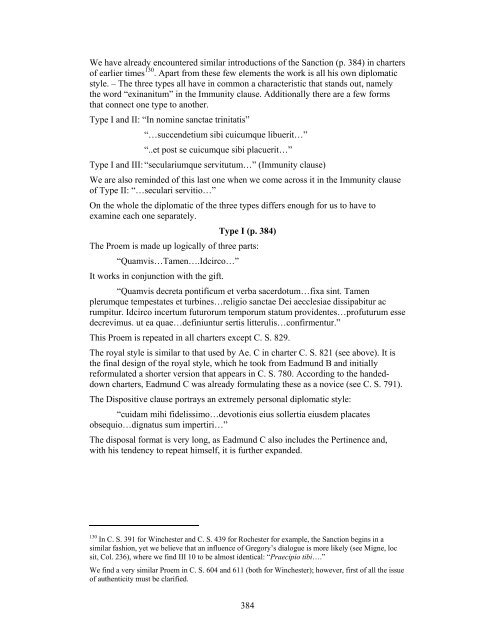Provisional Drogereit pdf
Provisional Drogereit pdf
Provisional Drogereit pdf
Create successful ePaper yourself
Turn your PDF publications into a flip-book with our unique Google optimized e-Paper software.
We have already encountered similar introductions of the Sanction (p. 384) in charters<br />
of earlier times 130 . Apart from these few elements the work is all his own diplomatic<br />
style. – The three types all have in common a characteristic that stands out, namely<br />
the word “exinanitum” in the Immunity clause. Additionally there are a few forms<br />
that connect one type to another.<br />
Type I and II: “In nomine sanctae trinitatis”<br />
“…succendetium sibi cuicumque libuerit…”<br />
“..et post se cuicumque sibi placuerit…”<br />
Type I and III: “seculariumque servitutum…” (Immunity clause)<br />
We are also reminded of this last one when we come across it in the Immunity clause<br />
of Type II: “…seculari servitio…”<br />
On the whole the diplomatic of the three types differs enough for us to have to<br />
examine each one separately.<br />
Type I (p. 384)<br />
The Proem is made up logically of three parts:<br />
“Quamvis…Tamen….Idcirco…”<br />
It works in conjunction with the gift.<br />
“Quamvis decreta pontificum et verba sacerdotum…fixa sint. Tamen<br />
plerumque tempestates et turbines…religio sanctae Dei aecclesiae dissipabitur ac<br />
rumpitur. Idcirco incertum futurorum temporum statum providentes…profuturum esse<br />
decrevimus. ut ea quae…definiuntur sertis litterulis…confirmentur.”<br />
This Proem is repeated in all charters except C. S. 829.<br />
The royal style is similar to that used by Ae. C in charter C. S. 821 (see above). It is<br />
the final design of the royal style, which he took from Eadmund B and initially<br />
reformulated a shorter version that appears in C. S. 780. According to the handeddown<br />
charters, Eadmund C was already formulating these as a novice (see C. S. 791).<br />
The Dispositive clause portrays an extremely personal diplomatic style:<br />
“cuidam mihi fidelissimo…devotionis eius sollertia eiusdem placates<br />
obsequio…dignatus sum impertiri…”<br />
The disposal format is very long, as Eadmund C also includes the Pertinence and,<br />
with his tendency to repeat himself, it is further expanded.<br />
130 In C. S. 391 for Winchester and C. S. 439 for Rochester for example, the Sanction begins in a<br />
similar fashion, yet we believe that an influence of Gregory’s dialogue is more likely (see Migne, loc<br />
sit, Col. 236), where we find III 10 to be almost identical: “Praecipio tibi….”<br />
We find a very similar Proem in C. S. 604 and 611 (both for Winchester); however, first of all the issue<br />
of authenticity must be clarified.<br />
384
















